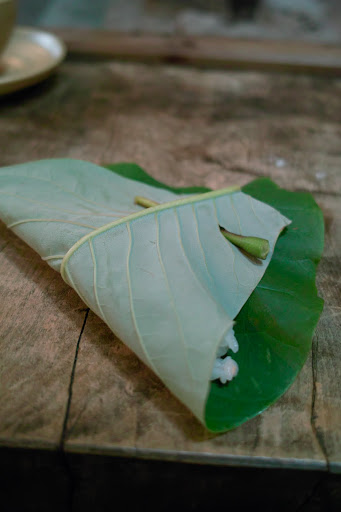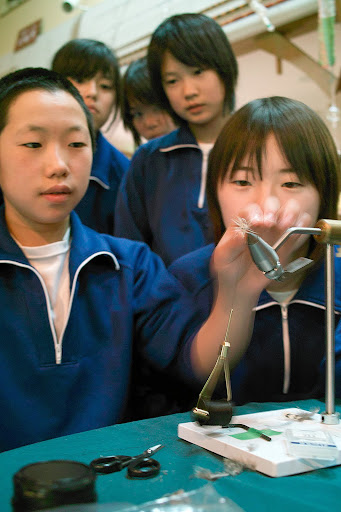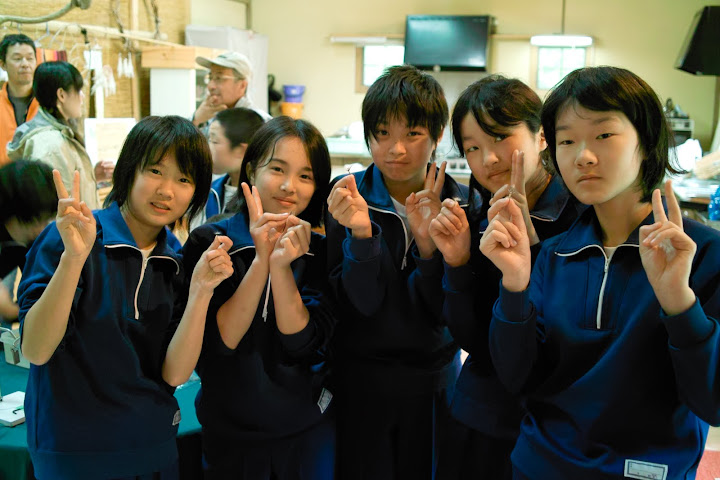Archive for June 2011
A day with tenkara craftsmen
Yesterday I headed south to visit two craftsmen. The primary purpose of this trip was to visit the renowned tenkara net maker (tenkara tamo) Mr. Yukihiro Yoshimura, of the store “Mankyu”.
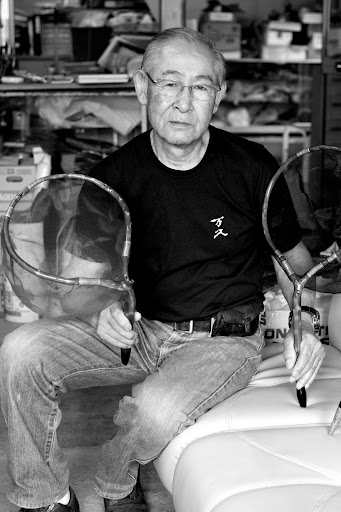
Visiting Mankyu was quite a dream. He’s the most renowned tenkara net maker in Japan and spending time looking at so many of his nets showed me he is a true master. Yoshimura-san has been making nets for 45 years, a craft he learned from his father. He’s also the longest practitioner of tenkara I know of , he’s been fishing tenkara for about 63 years.
Kuwata-san and I spent the morning with Yoshimura-san and his daughter, who helps him with the shop and works on connecting mesh bags to net frames. His daughter showed me how she connects the mesh bag to the nets by connecting a new bag to a frame I had made – they complimented my craftsmanship on the net construction, and gave me some invaluable pointers on finishing it. It was very impressive to see her skills at connecting the mesh to the frame, one of my most feared tasks. She said that often people make the frame and bring it to her for connecting the mesh.

We talked at length about tenkara nets. At one point in the conversation we discovered that both of us knew Katsutoshi Amano. Yoshimura-san picked up his cell phone and called Amano-san. Amano-san must have put in a good word for me, as Yoshimura-san then invited me to return and learn net making with him. I was definitely able to find time for that on my calendar, after all that’s one of the main reasons I wanted to come to Japan for an extended visit. I will be spending a full day with him the day before I return to the US.
Though I wish I had met him earlier to spend time learning about tenkara net making, this leaves me with an excellent reason to return next year, when I hope my Japanese will be much better. I will certainly write more about him after my day at his workshop. This encounter was quite a treat since Yoshimura-san frequently declines giving interviews to newspapers and magazines and has declined invitations by NHK to appear on tv.

I spent the night at the home of Kazuhiro Kuwata, who makes our tenkara leather wallets. It was great watching his craftsmanship as he finished a custom knife I had ordered for my own net making.
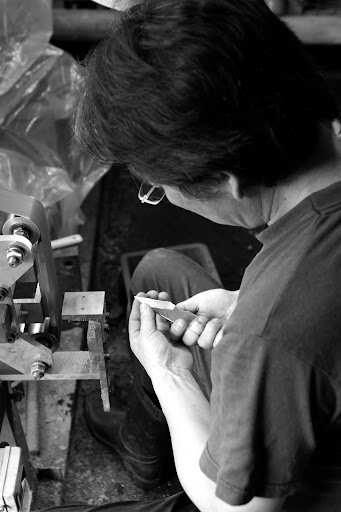
Kuwata-san lives and works in a large 100-year old traditional Japanese home in the country side. He loves vintage things and was attracted to the character of the house – which some people say is haunted.

We drank sake from his collection of Edo-period porcelain cups and enjoyed yakitori cooked on a irori . Kuwata-san doesn’t speak much English, so our conversations took place mostly in Japanese through the evening. Then he pulled out one of the vintage guitars he restored and played some American rock. These are experiences I wanted to have in Japan, and I’m happy I did.
Tenkara Class report
Back from a 2-day trip to Kaida-Kogen in Nagano prefecture. The event was incredibly fun, and I got to meet wonderful people.
In this picture Dr. Ishigaki teaching the class on day 2. Among other things he talked about the order one should try fishing a spot, start from the end of the pool and working your way up. He also demonstrated how working a spot from different directions can allow you to use different techniques (e.g. natural drift from below, pausing the fly from the side, dragging the fly from above, etc.)
Fishing was pretty difficult. I scored a few on Saturday, but got skunked yesterday. I had many drifts where I really expected a fish but nothing bit. I finally had a very nice rise at the end of the day, after Dr. Ishigaki and I had fished 3 other streams in the last couple of hours, and were at the end of our final 200 meter stretch with no bites of any kind. I got my fly to hang in one small spot long enough to get the interest of a fish, but I didn’t hook it.
The best thing about fishing frequently with someone who is a lot more experienced than you, is the confidence it gives you. Dr. Ishigaki likes to move quickly, so we’ll fish a stretch of a stream pretty fast and if nothing is happening we get on the car and check out a different section or different stream, as water temps or other factors may be different. But, there are days when it’s just not you, nor your technique, nor your flies, it’s just that the fish are not up to eating and there is not much that can be done about it.As has often been said, if it were much easier we wouldn’t call it “fishing”, we’d call it “catching”.
Preparing to fish a stream in the evening, the first of 3 Dr. Ishigaki would try in a couple of hours:
Moss-covered walls like these seem to be a constant presence on many streams. Walls have been built to prevent erosion of stream banks, since the water can get pretty high during heavy rains.
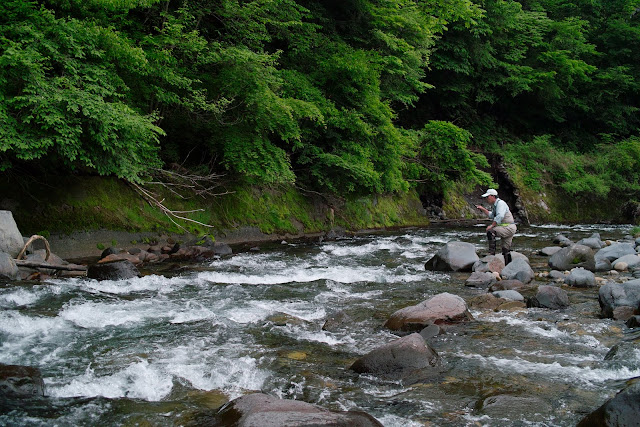
Our last stretch:
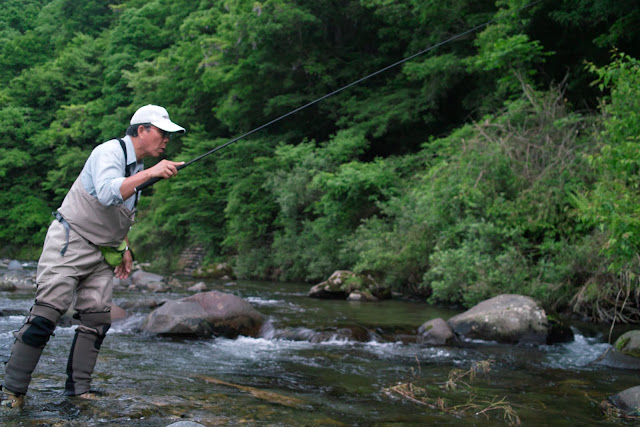
The inn we stayed in was pretty cool, a definite angler’s hangout. It’s called Mt. Ontake and run by Kazumitsu Suzuki and his wife. Here’s the URL for reference: http://www.mtontake.jp/. They served an awesome dinner and breakfast and at a very reasonable price.
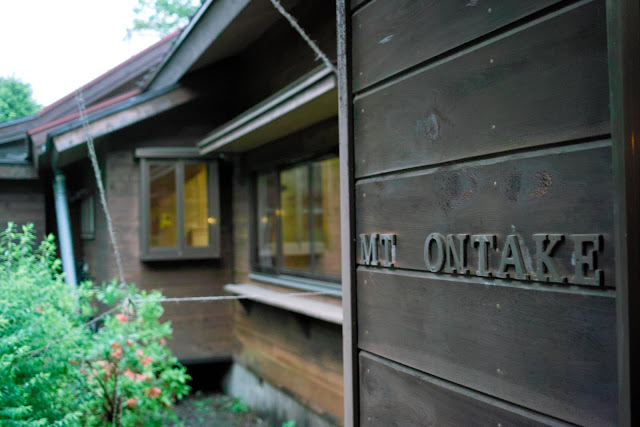
The spot is a regular destination for employees of the Patagonia store, which is how they got connected with Dr. Ishigaki. Last year he gave them a class on tenkara, and we’ll be there again this coming weekend to show them tenkara. It’s incredibly interesting how tenkara, Tenkara USA and the Patagonia company keep getting connected.
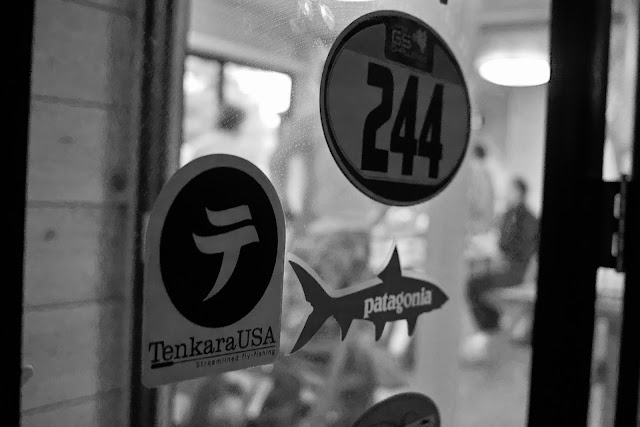
Suzuki-san and I got along great. He doesn’t speak English, but we were able to converse quite well about cameras, tenkara fishing, skiing and climbing Mt. Ontake, a trip we hope to do together next year. He even told me of a “secret” spot in Mt. Ontake area where he recently found several large Iwana but no one fishing as it’s a bit difficult to access. I may even be able to visit it before I leave.
Yesterday as the class took place, Suzuki-san took me around to fish in a couple of spots in the area. Suzuki-san is also a patrol for the streams in his area is responsible for checking anglers’ licenses. As he drove me around we stopped a couple of anglers. One didn’t have a license, but he readily pulled money to pay for it. Licenses typically cost about 1,000yen for a day ($12), and there is a penalty of 800yen if you’re caught without a license. Most people buy the license ahead of time, but it is a bit inconvenient to find the location to purchase one, so I don’t blame them for taking the chances without one.
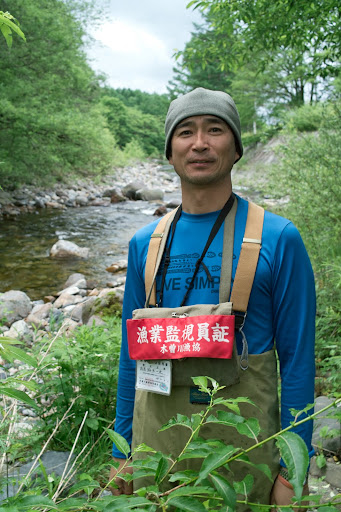
Tenkara in Japan – live
I thought I would not log on at all during the weekend, but found a few minutes of online time before heading to bed.
This morning I drove to Kaida-kogen, an area very popular among fishermen, for a tenkara class and fundraiser event with Dr. Ishigaki and Kurakami-san.
I left Maze at 6AM, arrived here at 8AM. It rained a little in the morning, and then hard in the afternoon. There were moments when the scenery was just awesome, at other moments the visibility was very low. Here’s a shot from one of the clear moments of the day when a layer of fog raises above the stream.
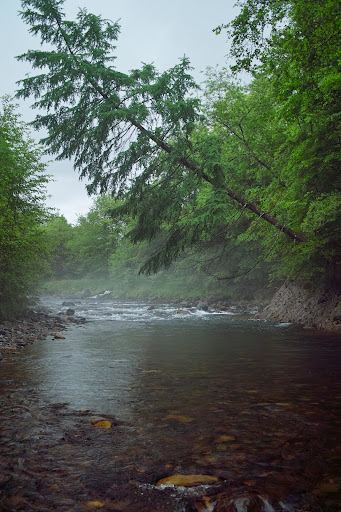
A little bragging, this morning I believe I was the only person to catch a fish in our group of about 15 people. And, in the afternoon I caught 4 fish, while the entire group had 1 fish among them. The stream has quite a few fish, but I believe the water was very cold today, and the fishing difficult. Not great numbers to really brag about, but it was easy to keep count today.

Here’s Ishigaki-sensei doing a demonstration to the class. He’s finally ditched the vest!!! Yes, he said it’s too hot and he doesn’t carry that many things in it anyways. I noticed he wasn’t using a vest on the Itoshiro event, so I finally asked him if he ditched it altogether.
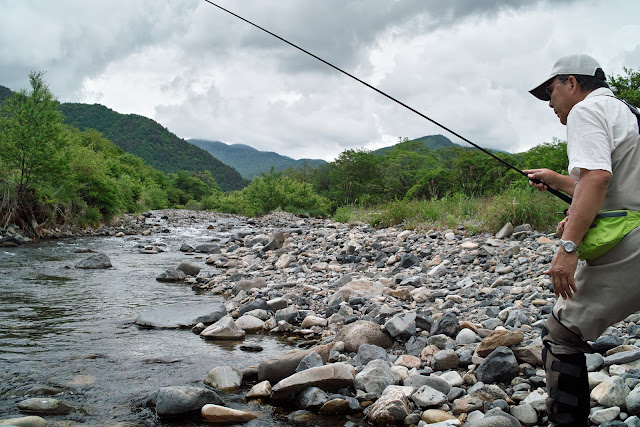
After fishing in heavy rain for about 4 hours, and catching my fair share for the day, I headed to an onsen. Just can’t seem to get enough of onsen, especially when it rains. I absolutely love that part of Japan for those rainy/cold days of fishing.
The most fun today may have been the charity event after dinner. Dr. Ishigaki and Kurakami san are taking every opportunity to raise some money for the earthquake victims. But, the event mostly consisted of underpricing things and if more than one person wanted the item they had to do rock/paper/scissors. It was a great way to have fun, but not a great way to raise money. I donated a Tenkara USA tshirt and a couple of sets of flies, those may have been the most popular items tonight. Then, the last item was the giveaway of a brand new Shimano tenkara rod. All those present participated in a rock/paper/scissors game to win the free rod. And, guess who won… yes, I did! But, I truly have no use for it as you may imagine, so I decided to turn it around and introduce an American-style auction into the party with bids starting at $50. The auction raised about $80, still a great bargain for the winner (photo below), but an additional chunk of money for the earthquake victims.

Pictures of tenkara fishing in Japan… and some Japanese terms for you
Tomorrow morning I’m headed for a 2-day tenkara event, and next week my schedule is packed. I hope to write more soon, but thought I’d leave you with a post of fishing before I go. This time I want to also share a few Japanese terms for specific types of stream, or terms that I use very often to figure out where to go fishing. Like the often cited example of eskimos have 30 words for different types of snow, the Japanese culture also developed a good vocabulary for describing their streams. To complete the post, I’ll include a couple of my best fish shots so far.
Japan has streams of many different kinds. The general term for river is “kawa“, but there are other more specific terms to describe different streams. Kawa can be “honryu“, which is the main stream, or “shiryu“, which are tributaries. Of course, a shiryu can also have other shiryus… Two other terms I use very often are “karyu“, which means downstream, or “jiuryu“, which means upstream.
Some are small, boulder strewn mossy streams. These are normally called “sawa“, the term for small streams, such as the one Yoshikazu Fujioka-san is fishing below, and my host Ikumi is fishing below that. I’ve been teaching Ikumi tenkara fishing and am very proud of how good her form is. We’ve only been out 3 times and her casting precision and technique impress me. She caught a fish on this evening (yumazume = evening activity period), Rocky and I didn’t.
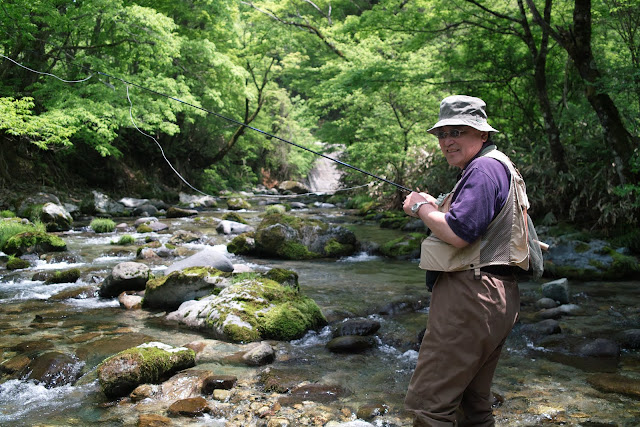

Mountain streams in general are called “keiryu”.
The keiryu below is being worked by Chris Stewart, the “Tenkara Bum”, who is referred by our Japanese friends as “tenkara baka”, though we’re still unsure that’s the best term for a bum. This was the “shiryu” to the Itoshiro, which is the “honryu” in the area we fished and one of the few catch and release streams in the country.

Keiryu also come in different styles. The clearest ones are called “seiryu”, which indicates they are “clear/beautiful/moving water types of streams. They may be large or small, but have the characteristic features of a mountain stream, boulders/pockets/currents. The Mazegawa is referred to as a seiryu. The Mazegawa has at least 100 distinct parts, that feel like entirely different streams. The one picture below shows my hosts, Ikumi on the foreground and Rocky farther downstream. The pool in front of her is about 12ft deep and we could easily see every rock below.
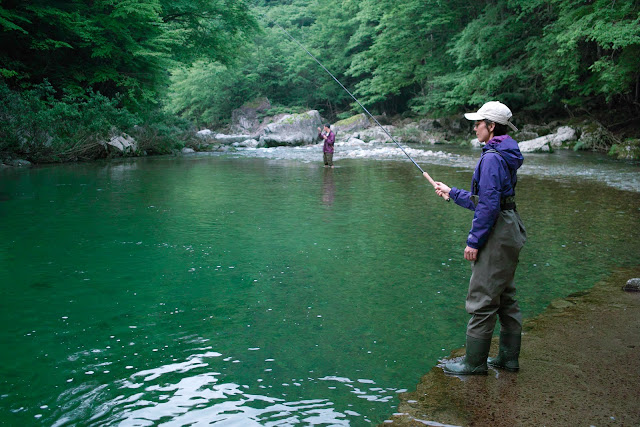
Some are large, slower rivers, these are just normally referred to with the general name “kawa/gawa” – there may be a more specific term, but I still haven’t learned it. The picture below was taken in Gujo soon after the ayu fishing season started. I’ll write more on ayu fishing later, but for now, suffice it to say it’s not tenkara! It’s done using a live “decoy fish”. It’s definitely a serious activity here. I may even call it “the bass fishing of mountain streams”.
Other streams are very steep, and the walls around it form a type of canyon. These are generally called “tani/dani”. These are the streams where people may do “shower climbing”, or sawanobori – interestingly, the activity is called “sawanobori”, because tani may or may not have water in it (it’s a canyon area), and shower climbing requires water, thus “sawanobori” is used. I helped take a group of kids on an outing to one of these streams, but no fishing allowed there. Next friday I’m scheduled to go explore a “tani” and will do some tenkara fishing. Actually, I’m supposed to catch lunch. Here’s the place I wish I had fished, but instead I enjoyed some awesome canyoning:
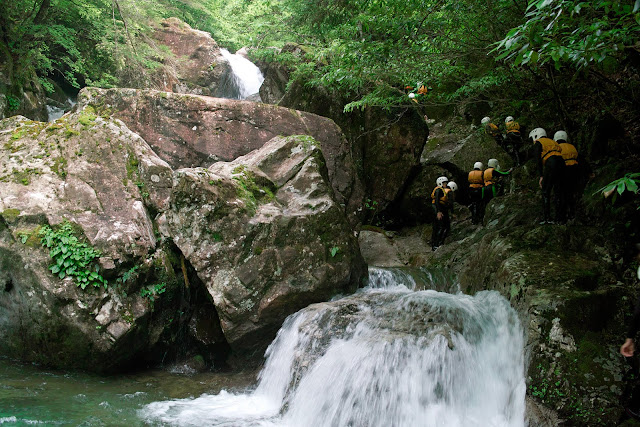
The fish here are just gorgeous, when I can see them I get excited about fishing again. In this area we can catch Iwana, and Amago. On the Japan sea side, one may find the yamame. Next week I have an outing scheduled with a local whose favorite stream is a couple of hours away and we can catch yamame.
This is a picture of a Iwana, my best fish on this trip. It’s not the largest fish one can catch here; last week on the ryokan I visited, the owner had a beautiful mounted display of a 20.5inches (52cm) Iwana. The Fishing Center has a dried 25inch Iwana on their wall. Tenkara was also used to catch some large fish.

Here is an amago I caught on a “shiryu”, the term for tributary. Notice the small red spots, the differentiating mark between the amago and the yamame. I hope to have a picture of yamame next week.

Visiting the tamo shops
Early this week I looked at my calendar and Wednesday was a free day – I have been busier on this trip than I had ever imagined. So, I decided to revisit the tamo shops a couple of hours away from here. This was my third visit. I actually had to return before I leave to pick up a couple of pre-ordered mesh bags for my nets. But, mostly I was excited to look at all the nets I could before the end of my trip.
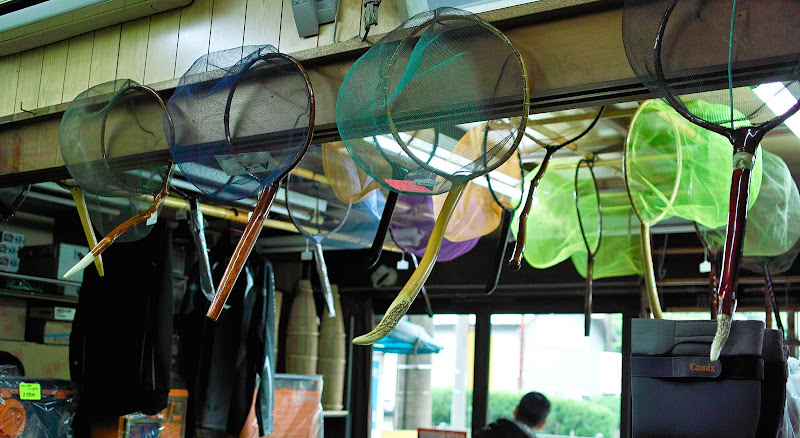
On the drive over, I noticed the same mountains I had seen when driving with Chris a couple of weeks ago. This time I found a better viewing spot and was able to setup my tripod for a more stable shot and some video.
Last year Dr. Ishigaki took me to visit one of the stores, where I fell in love with tenkara nets. Then, a few weeks ago Eiji Yamakawa and his friends came to this area, but as it was raining very heavily on our second day they decided to visit the tackle shops instead of going fishing, I tackled along. This time I wanted to go on my own. I wanted to take my time in observing the style of different net makers and I wanted to talk to the owners of the stores with no rush, no time to go back, and without feeling like I’m taking someone else’s time. Furthermore, this would be excellent Japanese practice.
My Japanese is still very crude, but I’m finding that on the topic of fishing I have been holding decent conversations, being able to ask the questions I want (even if sounding like a Tarzan), and understanding most of the responses. Sometimes I still count on my iPhone, which in Japan has become an expensive dictionary, though I’m relying on that less and less. Also, I do keep a small moleskin notebook and pen with me at all times and take note of new words and refer to ones I learned before. I have had numerous hour+ long conversations here, and those have been some of the most fun (though challenging) experiences in Japan. There is something about living on the country-side, where people seem open to taking their time in conversing with a stranger, arriving at common grounds and sharing common experiences. Whereas most encounters in big cities seem dictated by a one-hour time block, here I have sat for a cup of coffee and talked with people with no pre-allocated amount of time. Sometimes conversations are quick, other times 3 hours long, nonetheless each is a big opportunity to learn about 10,000 new things.
(by the way, though tenkara is mostly for smaller fish, if you still think it is only for the very small fish, take a look at the mounted fish on Shimizu’s wall, fish of that size or larger are a common decoration on walls of businesses in this area)
The first tamo shop I stopped at is owned by Shimizu-san. By far my favorite store and where I got my first net last year. A few weeks ago when we tried to stop by they were closed, so I was happy to find his store opened on this visit. Shimizu-san’s store has been around for about 40 years and was previously owned by his father. At this time of year, ayu fishing season is starting and the river across the street from his store was filled with ayu anglers (more on this later). A couple of times fishermen came in dressed in their neoprene waders to talk to Shimizu, as I admired each of the nets he had on display. This year’s collection of nets from different makers was nothing short of extraordinary. The nets were much more expensive than they had been last year, but each of the nets was of very high quality. Also, his store only stocked kaya-tree nets this year, as opposed to nets made from other trees like the “momi”. He says kaya nets are the best and he’s not carrying nets from other woods this year. He and I had a good conversation. I didn’t meet him last year, but he said his wife had mentioned meeting me last year.
Then, I revisited another store where I had stopped a few weeks earlier. I actually had to return to the area before I left since I had pre-ordered 2 custom mesh bags from the maker. I had asked if they had any mesh bags to sell, but they didn’t, preferring instead to use the bags for their own nets. However, he agreed to prepare a couple for me and have them ready within about 10 days. So, I stopped there and picked them up for my upcoming kaya nets. Here’s a picture of the maker about 30 years ago, this picture hung on the wall:
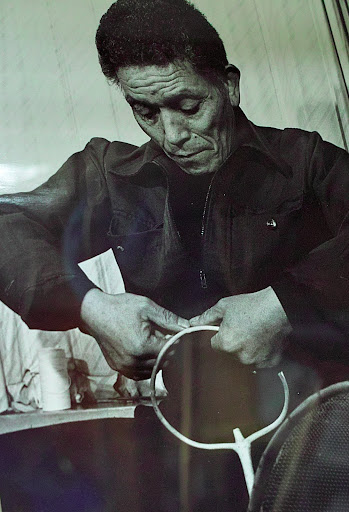
Remembering earthquake and tsunami victims 10,000 candles
This weekend the Mazegawa Fishing Center hosted the Hoba Sushi Festival. The highlight of the event was the lighting of 10,000 candles, made from recycled cooking oil, to remember those who lost their lives on the earthquake and tsunami disaster of March 11th. The candles lasted as long as 3 hours as those present enjoyed live performances by a group of artists. Everytime I looked around I was filled with awe from the energy around us. The moon popped behind the mountains on the other side of the river, candles lined up the small stream feeding the Mazegawa. It’s hard to put into words the energy I felt at the event, but thought I’d share a few pictures.
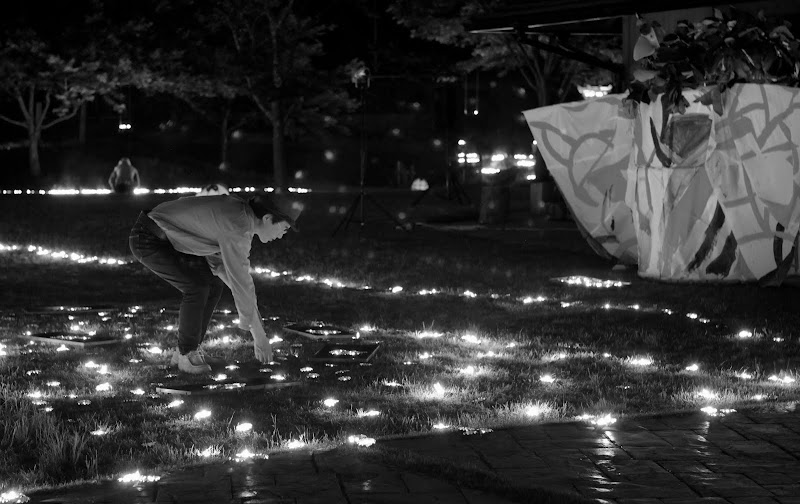


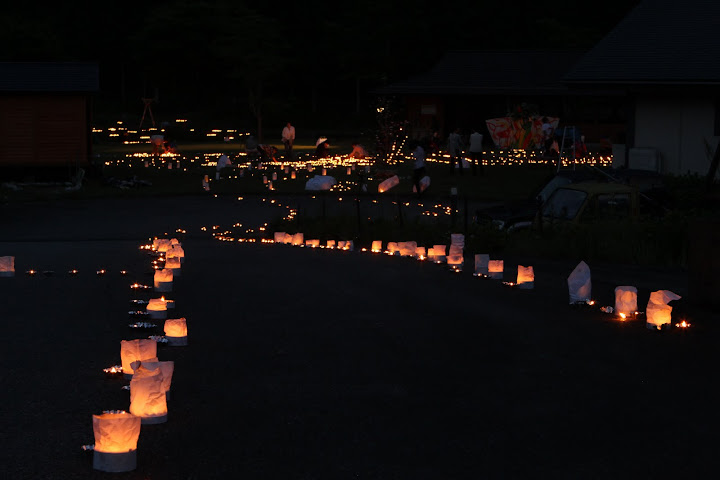




Today's view from my room
Actually, the title is a bit delayed. This was the view from my room yesterday, when I stayed at a most quaint ryokan (type of hotel) in the small town of Osaka 小坂 (not to be confused with the big city of Ōsaka, 大阪). In case anyone is interested in coming to this area (highly recommended if you can), the ryokan is the Sengakukan, very famous in the region (and for disclosure, I did receive free room and board without any expectations of promoting it, though I’m happy to do so).
Osaka is famous for its waterfalls and “shower climbing” (canyoning through waterfalls and pools). In all, the area is estimated to have over 216 waterfalls, though some people suspect it has even more falls that are hidden deep in the woods.
How I cam here was interesting. On Saturday, I met the owner of the ryokan here in Maze. She said her husband really likes fishing, and that I should get to know their town and possibly fish with him. She invited me to come the next day and stay there. What an awesome couple of days those were.
The ryokan was right next to a gorgeous river, which you can see on the picture above. The owners of the ryokan took me around town to see the waterfalls (they hiked around in their yukata robes, adding to the feel of “romantic Japan” that many people may have).
After hiking to the falls I met two local guides of my age, who volunteer as guides during the weekend. They said they do shower climbing and enjoy fishing. We agreed to fish the yumazume (the evening activity period) together. We were also treated to a 5-star dinner by the owners of the ryokan and were joined by their son who works there and is about my age. Unfortunately, we couldn’t find dates to go shower climbing/tenkara fishing together before I leave. I have to return next year so we can do the 3-day canyoning trek to Mt. Ontake.

The fishing was okay. As with most streams in Japan, the number of fish in the rivers was not that large. The fish that do remain in the water are just gorgeous, as they have not been beaten up by bad catch and release practices.
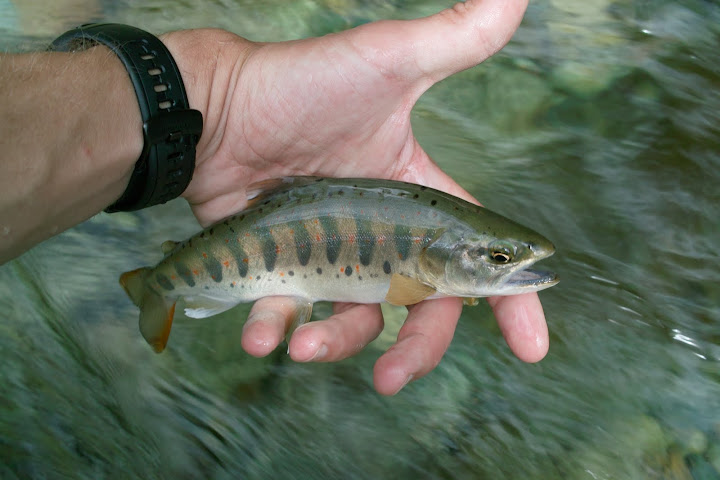
The stream behind the ryokan featured a few points where natural spring water bubbled up. The onsen water feeds a fountain inside the hotel where one may drink it – it has a very interesting soda texture to it, but tastes a bit like, well, fart (yes, the sulphuric smell of many onsen water sources). Apparently it’s very good for your health, but I could only must a glass of it. A few dishes are also cooked with that water. Hot onsen water also feeds the outdoor bath of the ryokan. Today I learned that the word onsen is used for both hot and cold spring water, though it’s normally associated with hot water in Japan.
I will have to write another post very shortly about the Hoba Sushi Festival over the weekend. It was a surreal event during the evening, as we lit 10,000 candles on the fishing center grounds and lining the banks of the stream next to it to remember the victims of the earthquake and tsunami.
Japan as a mountain painting
There are paintings that portray the mountains of Japan forming beautiful layers of colors. I have been seeing these pretty often when I drive to different fishing destinations. This was a shot taken when Chris and I were driving to Itoshiro. It was awesome to see 6 clear layers of mountains overlapping each other.
Tenkara in Misty Mountains
It is true, misty mountains, with a thin layer of fog just in the right place, may be a stereotypical image of Japan. Nonetheless, they are real. Images of these serene and somewhat mystical mountains probably come to the mind of many people when I say I’m spending time in a remote mountain area of Japan. They are a constant presence here, and sometimes very dramatic. Yesterday, after the rain stopped, there was a magic feel to the mountains above the Mazegawa; fog surrounded them, raised above the stream and made me feel as if I were in a movie set. I stopped the car and tried getting some good pictures. The fact that in my car I had a cd playing traditional flute music definitely helped set the mood.





